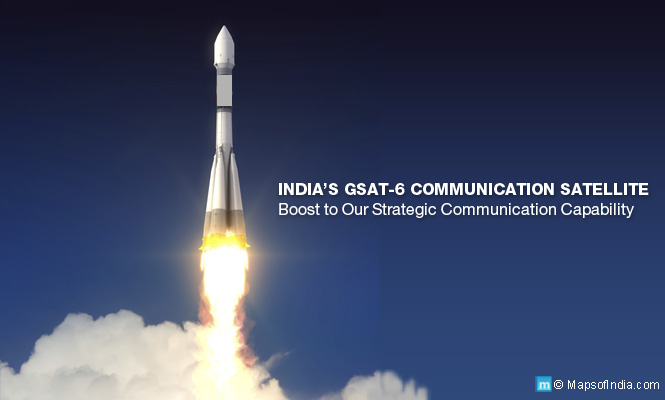ISRO is all set to add yet another feather to its expanding cap on 27 August when it will launch the 2,117-kg GSAT-6, an advanced communications satellite, into Geosynchronous Transfer Orbit (GTO). The GSAT-6 shall be launched into space by GSLV-D6 at 1652 hours IST on Thursday from the second launch pad at the Satish Dhawan Space Centre SHAR in Sriharikota.
Once injected into GTO by GSLV-D6, the initial orbit raising maneuvers of the GSAT-6 will be initiated by repeatedly firing Liquid Apogee Motor (LAM) on board the satellite. This will be followed by the deployment of the antennas and the three-axis stabilisation of the satellite before it is stationed at 83 degree East longitude. The entire process will be controlled by ISRO’s Master Control Facility located in Hassan, Karnataka.
Special Features of Gsat-6
The cuboid-shaped GSAT-6 is the 12th satellite developed and launched by ISRO and 25th of the total satellites launched into the geostationary orbit.
The satellite is expected to boost our strategic communication capability as it carries both S band and C band payloads and will help enhance communication capability through mobile consoles and very small handheld devices. The S band payload will provide five spot beams to users in India, while the C band payload will provide one national beam covering India for hub links.
The advanced features of GSAT-6 will include a 6-m wide Unfurlable S band Antenna, which is the largest launched by ISRO till date. The C band will use a 0.8-m fixed antenna. The antenna will be used for the five spot beams over India. For increasing frequency spectrum utilisation, these beams exploit the ‘frequency reuse schemes’. In another first, the Indian communication satellite will house the 70-V bus that will enhance its capability.
With a mission life of nine years, GSAT-6 will have a lift-off mass of 2,117 kg and a dry mass of 985 kg. The satellite carries 1,132 kg of propellant that comprises of MMH and MON-3.
Special Features of the Launch Vehicle: GSLV-D6
ISRO has demonstrated its capability by developing Cryogenic Upper Stage (CUS) technology and towards continuing its development process, GSLV-D6 will be using CUS-06 on board for the launch. This will be the third time ISRO will be using CUS and is the ninth flight of the GSLV. The GSLV series is designed to launch 2-ton class of satellites into GTO. The 49.1 m long GSLV-D6 has a lift-off mass of 416 tons. The metallic payload fairing has a diameter of 3.4 m.
Cryogenic Upper Stage (CUS) Technology
Developing cryogenic technology was no mean task. After the U.S.-led developed nations denied India access to this complex rocket stage launch capability, it was left to the scientists at ISRO to come up indigenous technology. To understand the complexity and challenge of using cryogenic technology, one must first understand that solid propellants or earth storable liquid propellants were earlier used for various rocket stage launches. These propellants when used at extremely low temperatures are associated with thermal and structural changes, especially as Oxygen liquefies at -183 deg C and Hydrogen at -253 deg C. At such low temperatures, a solid or liquid propellant does not perform as efficiently as CUS, which generates greater thrust for every kg of propellant burnt.
This mission is similar to the earlier GSLV-D5 launch in January 2014, when it launched GSAT-14 satellite into GTO. That launch too had three stages including CUS.
GSLV-D6 Follows the PSLV-C28/DMC3 Launch Mission Last Month
On 10 July this year, ISRO had launched the PSLV-C28 that carried three identical DMC3 optical earth observation satellites built by Surrey Satellite Technology Limited, U.K. The PSLV-C28 was the ninth launch in the PSLV series in XL configuration.
The nation will also recall ISRO’s very successful Mars Orbiter Mission (MOM), which was launched on board PSLV-C25 and placed India in the exclusive club of select nations to reach Mars. The next launch window will present itself in 2016.





